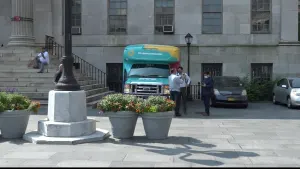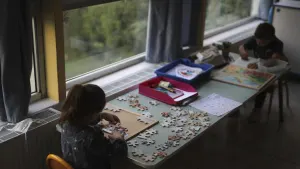More Stories
For many families, back to school planning will look different this year. Schools will have new policies in place to prevent the spread of COVID-19. You may also be starting the school year with virtual learning components. Whatever the situation, the Centers for Disease Control and Prevention has published a variety of checklists intended to help parents, guardians, and caregivers, plan and prepare for the upcoming school year.
Some of the changes in schools’ classroom attendance or structure may include:
Cohorts: Dividing students and teachers into distinct groups that stay together throughout an entire school day during in-person classroom instruction. Schools may allow minimal or no interaction between cohorts (also sometimes referred to as pods).
Hybrid: A mix of virtual learning and in-class learning. Hybrid options can apply a cohort approach to the in-class education provided.
Virtual/at-home only: Students and teachers engage in virtual-only classes, activities, and events.
Some of the changes in schools’ classroom attendance or structure may include:
Cohorts: Dividing students and teachers into distinct groups that stay together throughout an entire school day during in-person classroom instruction. Schools may allow minimal or no interaction between cohorts (also sometimes referred to as pods).
Hybrid: A mix of virtual learning and in-class learning. Hybrid options can apply a cohort approach to the in-class education provided.
Virtual/at-home only: Students and teachers engage in virtual-only classes, activities, and events.
MORE: Checklist for planning for in-person classes
MORE: Decision making checklist for virtual or at-home learning.
If you are planning on sending your child to school, here are 22 actions to take and points to consider:
1. Check in with your child each morning for signs of illness. If your child has a temperature of 100.4 degrees or higher, they should not go to school.
2. Make sure your child does not have a sore throat or other signs of illness, like a cough, diarrhea, severe headache, vomiting, or body aches.
3. If your child has had close contact with a COVID-19 case, they should not go to school. Follow guidance on what to do when someone has known exposure - see more here.
4. Identify your school point person(s) to contact if your child gets sick.
5. Be familiar with local COVID-19 testing sites in the event you or your child develops symptoms. These may include sites with free testing available.
6. Make sure your child is up-to-date with all recommended vaccines, including for flu. All school-aged children should get an influenza flu vaccine every season, with rare exceptions. This is especially important this year because we do not yet know if being sick with COVID-19 at the same time as the flu will result in more severe illness.
7. Review and practice proper hand washing techniques at home, especially before and after eating, sneezing, coughing, and adjusting a face cover. Make hand washing fun and explain to your child why it’s important. See more tips from the CDC here.
1. Check in with your child each morning for signs of illness. If your child has a temperature of 100.4 degrees or higher, they should not go to school.
2. Make sure your child does not have a sore throat or other signs of illness, like a cough, diarrhea, severe headache, vomiting, or body aches.
3. If your child has had close contact with a COVID-19 case, they should not go to school. Follow guidance on what to do when someone has known exposure - see more here.
4. Identify your school point person(s) to contact if your child gets sick.
5. Be familiar with local COVID-19 testing sites in the event you or your child develops symptoms. These may include sites with free testing available.
6. Make sure your child is up-to-date with all recommended vaccines, including for flu. All school-aged children should get an influenza flu vaccine every season, with rare exceptions. This is especially important this year because we do not yet know if being sick with COVID-19 at the same time as the flu will result in more severe illness.
7. Review and practice proper hand washing techniques at home, especially before and after eating, sneezing, coughing, and adjusting a face cover. Make hand washing fun and explain to your child why it’s important. See more tips from the CDC here.
8. Be familiar with how your school will make water available during the day. Consider packing a water bottle.
9. Develop daily routines before and after school - for example, things to pack for school in the morning (like hand sanitizer and an additional (back up) cloth face covering) and things to do when you return home (like washing hands immediately and washing worn cloth face coverings).
MORE: 11 things to consider if your school is requiring the use of cloth face coverings
MORE: 14 tips for effectively wearing a face cloth covering
10. Talk to your child about precautions to take at school. Children may be advised to wash and sanitize their hands more often, keep physical distance from other students, wear a cloth face covering, avoid sharing objects with other students, including water bottles, devices, writing instruments, and books, and use hand sanitizer.
10. Talk to your child about precautions to take at school. Children may be advised to wash and sanitize their hands more often, keep physical distance from other students, wear a cloth face covering, avoid sharing objects with other students, including water bottles, devices, writing instruments, and books, and use hand sanitizer.
11. Develop a plan as a family to protect household members who are at increased risk for severe illness.
12. Make sure your information is current at school, including emergency contacts and individuals authorized to pick up your child(ren) from school. If that list includes anyone who is at increased risk for severe illness from COVID-19, consider identifying an alternate person.
13. Be familiar with your school's plan for how they will communicate with families when a positive case or exposure to someone with COVID-19 is identified and ensure student privacy is upheld.
MORE: 8 changes you can expect when schools reopen this fall across the tri-state
14. Plan for possible school closures or periods of quarantine. If transmission is increasing in your community or if multiple children or staff test positive for COVID-19, the school building might close. Similarly, if a close contact of your child (within or outside of school) tests positive for COVID-19, your child may need to stay home for a 2-week quarantine period. You may need to consider the feasibility of teleworking, taking leave from work, or identifying someone who can supervise your child in the event of school building closures or quarantine.
15. Plan for transportation. If your child rides a bus, plan for your child to wear a cloth face covering on the bus and talk to your child about the importance of following bus rules and any spaced seating rules. If carpooling, plan on every child in the carpool and the driver wearing cloth face coverings for the entire trip. If your school uses the cohort model, consider finding families within your child’s group/cohort at school to be part of the carpool.
16. If your child has an Individualized Education Program (IEP) or 504 Plan or receives other learning support (e.g., tutoring), ask your school how these services will continue.
17. If your child receives speech, occupational or physical therapy or other related services from the school, ask your school how these services will continue.
18. If your child receives mental health or behavioral services (e.g., social skills training, counseling), ask your school how these services will continue.
19. If your school uses a cohorting model, consider limiting your child’s in-person out-of-school interactions to children in the same cohort or to activities where physical distancing can be maintained.
20. Reinforce the concept of physical distancing with your child.
21. Talk to your school administrators and teachers about their plans for physical education and physical activity. Safer options include being outdoors when possible, reducing the number of people in an indoor space, and encouraging students to stay at least 6 feet apart.
22. Ask how your school plans to help ensure that students are following practices to reduce the spread of COVID-19.
Source: Centers for Disease Control and Prevention
12. Make sure your information is current at school, including emergency contacts and individuals authorized to pick up your child(ren) from school. If that list includes anyone who is at increased risk for severe illness from COVID-19, consider identifying an alternate person.
13. Be familiar with your school's plan for how they will communicate with families when a positive case or exposure to someone with COVID-19 is identified and ensure student privacy is upheld.
MORE: 8 changes you can expect when schools reopen this fall across the tri-state
14. Plan for possible school closures or periods of quarantine. If transmission is increasing in your community or if multiple children or staff test positive for COVID-19, the school building might close. Similarly, if a close contact of your child (within or outside of school) tests positive for COVID-19, your child may need to stay home for a 2-week quarantine period. You may need to consider the feasibility of teleworking, taking leave from work, or identifying someone who can supervise your child in the event of school building closures or quarantine.
15. Plan for transportation. If your child rides a bus, plan for your child to wear a cloth face covering on the bus and talk to your child about the importance of following bus rules and any spaced seating rules. If carpooling, plan on every child in the carpool and the driver wearing cloth face coverings for the entire trip. If your school uses the cohort model, consider finding families within your child’s group/cohort at school to be part of the carpool.
16. If your child has an Individualized Education Program (IEP) or 504 Plan or receives other learning support (e.g., tutoring), ask your school how these services will continue.
17. If your child receives speech, occupational or physical therapy or other related services from the school, ask your school how these services will continue.
18. If your child receives mental health or behavioral services (e.g., social skills training, counseling), ask your school how these services will continue.
19. If your school uses a cohorting model, consider limiting your child’s in-person out-of-school interactions to children in the same cohort or to activities where physical distancing can be maintained.
20. Reinforce the concept of physical distancing with your child.
21. Talk to your school administrators and teachers about their plans for physical education and physical activity. Safer options include being outdoors when possible, reducing the number of people in an indoor space, and encouraging students to stay at least 6 feet apart.
22. Ask how your school plans to help ensure that students are following practices to reduce the spread of COVID-19.
Source: Centers for Disease Control and Prevention
More from News 12
1:48

Mobile vaccine van parks at Brooklyn Borough Hall
0:23

New Excelsior Pass Plus app extends beyond New York jurisdiction

Your Coronavirus 2020 Photos

10 online learning tools for students to use at home
11:21:40

6 tips for home schooling children and remote learning
